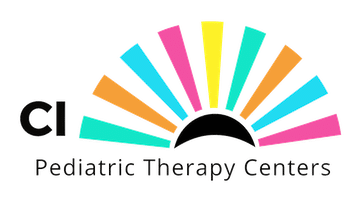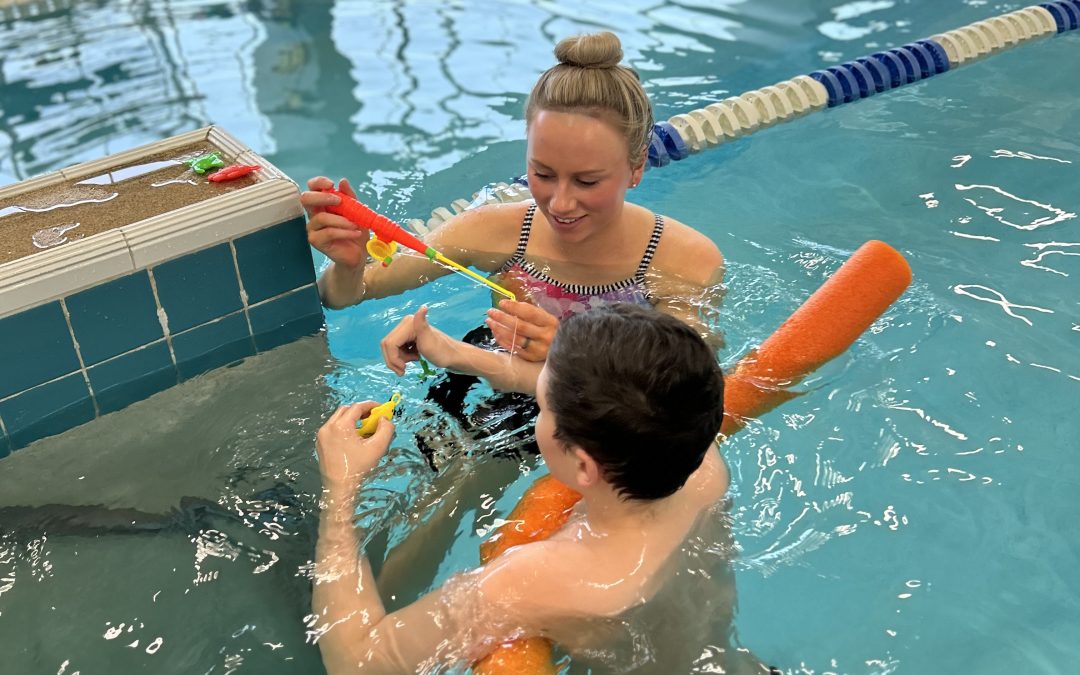Pediatric aquatic therapy is a therapeutic service that provides individualized physical and occupational therapy in a pool-based setting. Pediatric aquatic therapy is often used as a supplement to land-based therapy services by facilitating increased range of motion and strength, decreased pain and discomfort, and immersion into a therapeutic sensory environment. Pediatric aquatic therapy is for children with neuromotor differences, congenital disorders, developmental delays, sensory processing differences, autism, and so much more.
Pediatric aquatic therapy has been used for decades, even in the early 1900’s. Conditions that were frequently treated included cerebral palsy, polio, and rehabilitation for injuries sustained in war. In recent years, aquatic therapy for pediatric clients has been increasingly supported by clinical research and available more widely for clients of various ages and abilities.
At CI Pediatric Therapy Centers, a neurodiversity affirming approach is used to ensure individualized care for children participating in both physical and occupational aquatic therapies. Both licensed physical and occupational therapists at CI Pediatric Therapy Centers utilize client-centered, functional goals to guide aquatic therapy treatment while promoting growth, independence, and (most importantly!) play.
Aquatic Therapy Benefits for Children
Pediatric aquatic therapy promotes development in physical, sensory, and psychological skills.
Some of the many benefits of aquatic physical and occupational therapy include:
- Reduced pain: Water supports body weight, making movement easier and less painful.
- Improved range of motion: The gentle support of the water can increase flexibility and range of motion.
- Increased strength: Water provides gentle resistance during movement, like a built-in weight room! This helps build stronger muscles.
- Improved balance and coordination: Water challenges balance in a safe way, helping kids have more control over their movements.
- Increased weight bearing ability: The water supports body weight, so kids can practice putting weight on sore or injured areas without as much pain. This helps them get back to activities they love.
- Improved cardiorespiratory/cardiovascular and pulmonary endurance: Exercises in the water get the heart rate up and improve breathing, just like other forms of exercise.
- Improved motor skills and planning: Fun activities in the water help develop coordination, agility, and problem-solving skills.
- Boosted confidence: As your child gets stronger and more coordinated in the water, their confidence will grow!
Aquatic Occupational and Physical Therapy for Children
Aquatic occupational and physical therapy supplement on-land OT and PT sessions to further facilitate confidence, safety, and independence in everyday activities. Aquatic occupational and physical therapy are focused on using play-based, client-centered activities as a means to improve gross motor skills, strength, coordination and functioning during daily occupations including academic tasks, daily routines, self-cares, play, and social interactions.
Examples of common goals addressed through aquatic occupational and physical therapy might include:
- Improved strength
- Increased range of motion
- Increased endurance
- Executive functioning
- Following directions, attention, problem-solving, inhibition, and planning/organization
- Sensory processing
- Targeting modulation and integration of tactile, auditory, visual, vestibular, and proprioceptive sensory input within the pool environment.
- Safety Awareness
- Safety during transition periods
- Self-Regulation
- Bilateral coordination
- Postural control
- Motor coordination and praxis
- Self-esteem, confidence, and motivation
- Dressing skills
Common interventions or activities used during aquatic occupational and physical therapy sessions include:
- Scavenger hunts to practice following directions, increase attention, and strengthen visual skills.
- Thoughtfully scaffolded support, through the use of tools such as kickboards or pool noodles to support motor coordination while kicking, pulling, or gliding.
- Retrieving materials found around the pool deck to support impulse control and safety awareness within the pool environment.
- Facilitating sensory processing and integration through sensory-based water play.
- Gradually extending distance or duration of movement (swimming, walking, or running) in the water.
- Targeting visual tracking, bilateral coordination and gross motor coordination through age-appropriate pool games such as tossing a beach ball back-and-forth.
Choosing the Right Aquatic Therapy Program
Choosing the right aquatic therapy program is key to promoting growth and development in your child. Factors and related topics to inquire about include:
- The facility: Does the facility being used have the adaptive equipment needed for your child to feel successful? Will your child enjoy the temperature of the pool at this facility? Are there clear safety measures in place throughout the facility?
- The therapist: Does your therapist have the experience and credentials needed to support your child? Is the therapist able to connect with and readily engage your child in therapeutic activities from the start? Does the therapist provide a variety of activities and explain how each aquatic session benefits your child?
- The program: Is your child’s program focused on play and inclusion? Does the therapist prioritize your family’s functional goals during treatment? Are expectations for you as a parent clear?
Could Aquatic Therapy Be the Right Support for Your Child’s Development?
Pediatric aquatic therapy is a pool-based service that can supplement traditional physical and occupational therapy services to promote strength, coordination, independence, sensory processing, and many more skills. Aquatic therapy at CI Pediatric Therapy Centers utilizes individualized, play-based care to meet you and your family’s needs. Due to the wide range of abilities, disorders, and differences aquatic therapy can support, it may be worth pursuing such a service to facilitate your child’s development.
Contact CI Pediatric Therapy Centers at citherapies.com or call 608-819-6394 for more information.
Next Steps: Pursuing Aquatic Therapy for Your Child
CI Pediatric Therapies is a family-centered organization that supports the growth and development of all children through play and evidence-based therapy services. If pediatric aquatic therapy is a service that aligns with your child’s goals or if you have any questions, please visit CI Pediatric Therapy Centers’ website at citherapies.com or click here to directly schedule a consultation.

